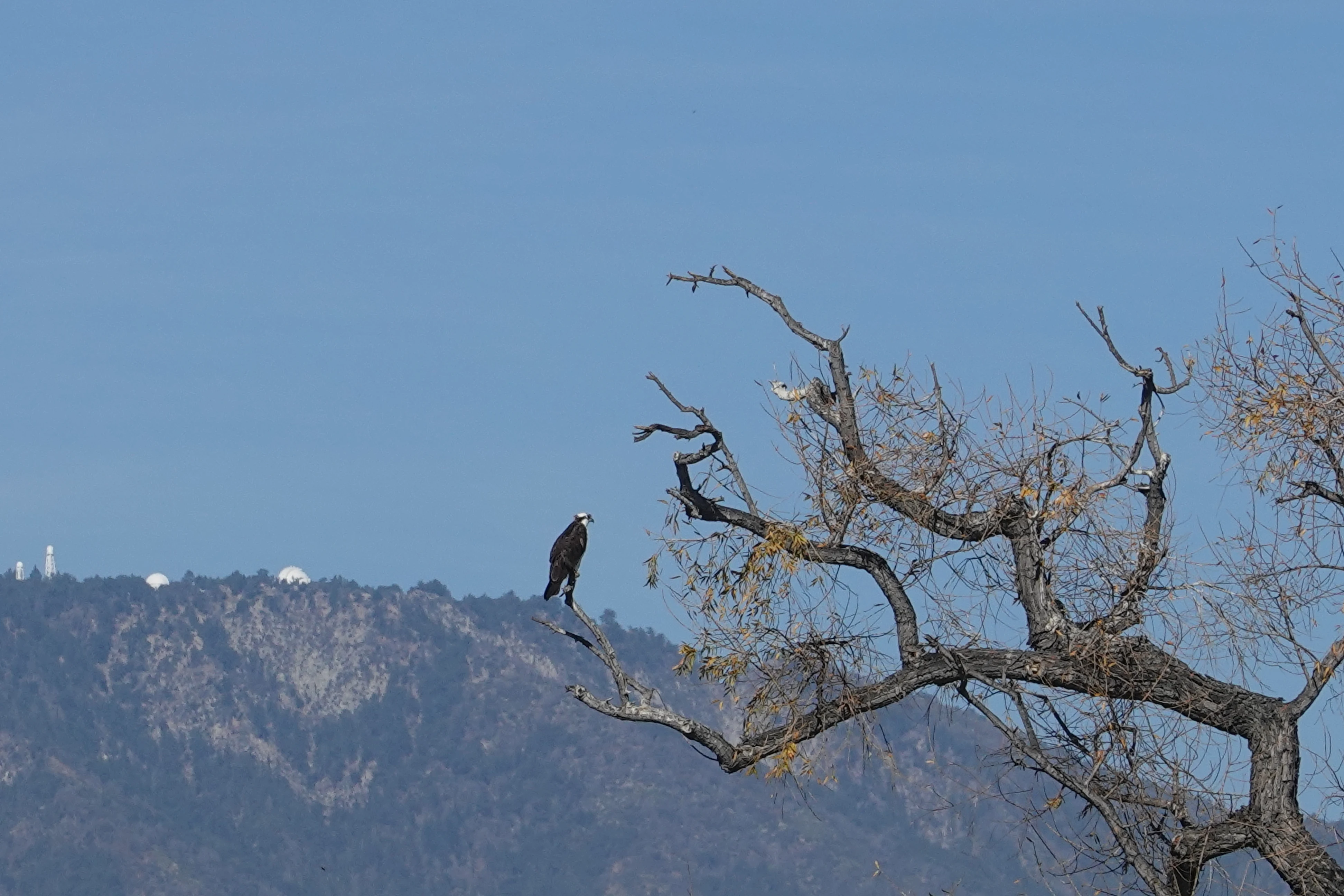The osprey also called sea hawk, river hawk, and fish hawk — is a diurnal, fish-eating bird of prey in the Pandionidae family. I saw ospreys flying high in the sky in 2020 and 2021. When I noticed one osprey standing in the treetops for a long time in 2022, I was very excited that I could see it closely. I saw a bird’s nest behind it and wondered if it was guarding its nest. There is a dam in front of it. I also wondered if it was just watching to see if there were any big fish that it could prey on. Since the last time I saw an osprey at the Santa Fe Dam was on March 31, 2021 and this time was on March 14, 2022, it makes me wonder if the osprey is a migratory bird. I learned that Ospreys migrate because fish become inaccessible. Ospreys eat 99% fish, which are cold-blooded and sensitive to changes in temperature. When the weather is warm during the Spring and Summer, ospreys can easily catch fish near the surface. As temperatures cool, fish will go deeper to warmer water. Likewise, fish that normally live in shallow waters seek refuge in deeper waters, making them inaccessible to Ospreys. Therefore Ospreys must migrate in order to find fish to prevent starving to death. Ospreys migrate alone. Males, females, and juveniles migrate independently, unlike most migratory North American raptors. Even mated pairs do not migrate together.
鶚也被稱為海鷹,河鷹和魚鷹-是一種屬鶚科晝出夜息善於捕魚的猛禽。2020年及2021年看到的魚鷹都是高高飛在天上,2022年這次突然瞄到一隻魚鷹駐立在樹梢上好長一段時間,我很興奮能近距離看到它。。我看到一個鳥巢在它身後,不知道它是不是在看守它的巢穴。在它身前是一個水壩,讓我猜想還是它在靜觀有沒有什麼大魚它可以捕食。由於上次在聖達菲大壩看到魚鷹是在2021年3月31日,而這次是2022年3月14日,就讓我想知道魚鷹是否是一種候鳥。我找到魚鷹遷移的原因是因為吃不到魚。 魚鷹的食物99%是魚,這些魚是冷血動物,對溫度變化很敏感。 春季和夏季天氣溫暖時,魚鷹很容易在水面上捕魚。 隨著溫度的降低,魚會潛入到較深的溫暖水中。 同樣,通常生活在淺水區的魚會在更深的水域尋求庇護,使魚鷹無法接近它們。 因此魚鷹必須遷徙才有魚吃以防止餓死。 與大多數遷徙的北美猛禽不同,魚鷹是獨自遷徙,雄鷹、雌鷹和幼鷹個自遷徙。 即使是交配的配偶也不會一起遷移。













Notes 筆記
- The osprey also called sea hawk, river hawk, and fish hawk — is a diurnal, fish-eating bird of prey in the Pandionidae family.
- It is a large raptor, reaching more than 60 cm (24 in) in length and 180 cm (71 in) across the wings. It is brown on the upperparts and predominantly greyish on the head and underparts.
- The osprey tolerates a wide variety of habitats, nesting in any location near a body of water providing an adequate food supply. The osprey is the second most widely distributed raptor species, after the peregrine falcon. It is found on all continents except Antarctica, although in South America it occurs only as a non-breeding migrant.
- An Osprey may log more than 160,000 migration miles during its 15-to-20-year lifetime.
- The osprey is piscivorous, with fish making up 99% of its diet. Ospreys have vision that is well adapted to detecting underwater objects from the air. Ospreys are excellent anglers. Over several studies, Ospreys caught fish on at least 1 in every 4 dives. The average time they spent hunting before making a catch was about 12 minutes. Occasionally, the osprey may prey on rodents, rabbits, hares, other birds, and small reptiles.
- The osprey differs in several respects from other diurnal birds of prey. Its toes are of equal length, its tarsi are reticulate, and its talons are rounded, rather than grooved. The osprey and owls are the only raptors whose outer toe is reversible, allowing them to grasp their prey with two toes in front and two behind. This is particularly helpful when they grab slippery fish.
- The osprey breeds near freshwater lakes and rivers, and sometimes on coastal brackish waters. Ospreys usually mate for life. Rarely, polyandry has been recorded.
- Osprey eggs do not hatch all at once. Rather, the first chick emerges up to five days before the last one. The older hatchling dominates its younger siblings, and can monopolize the food brought by the parents. If food is abundant, chicks share meals in relative harmony; in times of scarcity, younger ones may starve to death.
- In Buddhism, the osprey is sometimes represented as the "King of Birds"
- The osprey is mentioned in the famous Chinese folk poem "guan guan ju jiu" (關關雎鳩); "ju jiu" 雎鳩 refers to the osprey, and "guan guan" (關關) to its voice. In the poem, the osprey is considered to be an icon of fidelity and harmony between wife and husband, due to its highly monogamous habits. Some commentators have claimed that "ju jiu" in the poem is not the osprey but the mallard duck, since the osprey cannot make the sound "guan guan".
- In heraldry, the osprey is typically depicted as a white eagle, often maintaining a fish in its talons or beak, and termed a "sea-eagle." It is historically regarded as a symbol of vision and abundance; more recently it has become a symbol of positive responses to nature, and has been featured on more than 50 international postage stamps.
- 鶚也被稱為海鷹,河鷹和魚鷹-是一種晝出夜息善於捕魚的猛禽屬鶚科。
- 鶚是體型大的猛禽,長約60公分(24英吋),翼展達180公分(71英吋)。上身呈棕色,頭部及下身主要呈灰色。
- 鶚可以適應各種各樣的棲息環境,可在食物充足的水域周圍任何地點築巢。 鶚是僅次於遊隼的第二種分佈最廣的猛禽。除南極洲以外的所有大洲都可以找得到它。而在南美它是非繁殖季的候鳥。
- 魚鷹在其15至20年的生命中可能會記錄超過160,000英里的遷移里程。
- 魚鷹是魚食性的,魚占其飲食的99%。魚鷹有非常特殊從空中探測水下物體的視力。魚鷹是出色的垂釣者。 在數項研究中,魚鷹每4次潛水至少捕獲1條魚。 他們抓魚之前平均花費狩獵時間約12分鐘。偶爾它也會捕食囓齒動物,兔子,野兔,其他鳥類和小型爬行動物。
- 魚鷹與其他晝出夜息的猛禽在幾個方面有所不同。 它的腳趾等長,跗骨是網狀的,而且爪子是圓形的,而不是開槽形的。 魚鷹和貓頭鷹是唯一外趾可翻轉的猛禽,前面有兩個腳趾,後面有兩個腳趾,使它們能夠抓住獵物,在抓住滑的魚時特別有用。
- 魚鷹通常在淡水湖泊和河流附近繁殖,有時在沿海鹹水上繁殖。魚鷹通常是一夫一妻。 很少有一妻多夫的記錄。
- 魚鷹的卵不會一次全部孵化。 最後一隻小魚鷹可能在第一隻小魚鷹出生後的五天孵出。 較先孵化出的魚鷹比其年輕的兄弟姐妹佔優勢地位,可以壟斷父母帶回來的食物。 如果食物多,小魚鷹們會和諧的分食。 但食物匱乏的時候,年紀較小的魚鷹可能會餓死。
- 在佛教中,魚鷹有時被稱為“鳥類之王”
- 中國著名的民間詩詞“關關雎鳩”中提到了魚鷹。 “ ju jiu”是指魚鷹,而“關關”是指其聲音。 在這首詩中,由於魚鷹一夫一妻制的習性,它被視為夫妻之間忠實和和諧的象徵。 一些評論家聲稱,詩歌中的“雎鳩”不是魚鷹,而是綠頭鴨,因為魚鷹不能發出“關”的聲音。
- 在紋章學中,魚鷹常被描繪成一隻白鷹,因為它的爪或喙可叼一條魚,故被稱為“海鷹”。 過去它被視為有遠見和豐裕的象徵; 最近它已成為對自然正面回應的象徵,在50多種國際郵票上可得到它。
References 參考資料
- Wikipedia: Osprey
- All about birds: Osprey
- 維基百科: 鹗
- Avian Report: Osprey Migration
Birds Posts 鳥的帖子
Comments